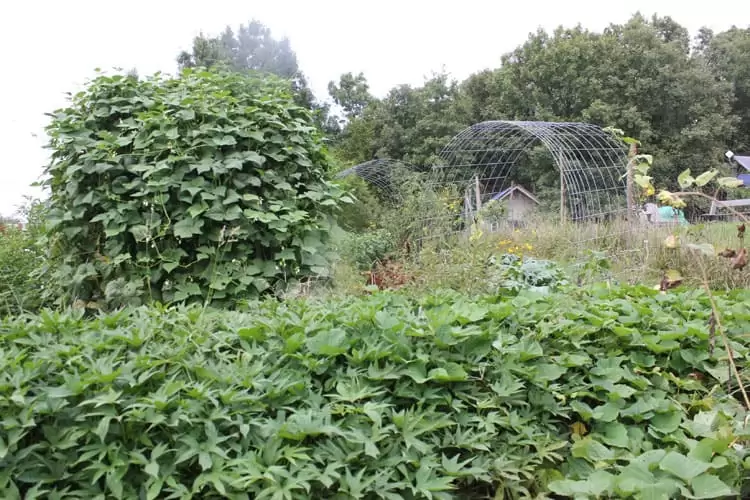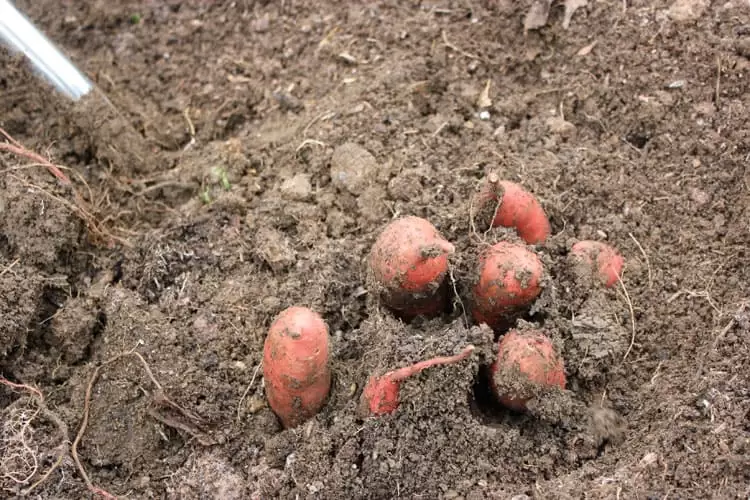In this post, I’ll share not only how to grow sweet potatoes, but also how to harvest, cure and store them to enjoy all winter long!
Over the past few years, my gardening efforts have shifted from growing a bit of everything to growing what does best in my climate and what actually fills the bellies of my family.
That has meant fewer melons and more potatoes; only one trellis of cucumbers and three beds of winter squash. And because they are incredibly easy to grow in our zone 5b garden, lots and lots of sweet potatoes.
In this post, I’ll share how to grow sweet potatoes and how to harvest, cure and store them all winter long!
How to Grow Sweet Potatoes from Slips
Sweet potatoes mature in 90-170 days, so a long growing season is essential to your crop’s success.
Sweet potatoes are planted using sprouts called “slips” which you can either sprout yourself from stored sweet potatoes, or purchase (we get ours from the local Amish store, but you can also source them here.)
I prepare garden beds for sweet potato slips by using a digging fork and gently aerating the soil. I then add some compost, manure, and any other amendments I have on hand (wood ash, for instance). and gently turn over the soil.
It is important to add fertility without adding too much nitrogen, otherwise, your sweet potatoes will vine forever without producing abundant tubers.
You also want the soil to be nice and “fluffy” so your tubers can grow freely.
Sweet potato slips are planted every 12″ at a depth of roughly 6″. As you can see in the photo above, they start out looking like scraggly weeds!
But before long, your sweet potato vines will grow to cover the entire bed… and then some!
How to Harvest Sweet Potatoes
Sweet potatoes form a lush mat of vining growth, and their tubers form underground, so it can be hard to know when to harvest sweet potatoes.
About 4 months after planting sweet potato slips, you can dig up a few and see how large they’ve grown. Or you can wait until just before your first frost and harvest them then.
I have read that it is okay to wait to harvest sweet potatoes until after the first frost, when the sweet potato vines turn black.
However, I do not like this approach because it increases your risk of the tubers rotting in storage. Instead, I just watch the weather and make sure I lift the tubers out of the ground before a frost.
When we are ready to harvest the sweet potatoes, we roll the mat of vines down the bed, almost like rolling up a sleeping bag – it’s really that easy! You can see the technique in the photo below.
Once the bed has been cleared of sweet potato vines, we use a digging fork to gently loosen the soil around each cluster of tubers. You’ll want to be careful and gentle here so you do not puncture the tubers.
The kids love this part of the sweet potato harvest, as it’s like a treasure hunt to dig down and discover all of the hidden tubers!
How to Cure Sweet Potatoes
I recently cooked up some sweet potatoes from the Farmer’s market and discovered that they were tasteless and certainly not sweet. It was because they were not cured before sale.
To cure sweet potatoes you will store them in a temperature of 80-85 degrees F with a humidity of 80-90% for a period of 5-10 days.
This process begins to trigger the development of sugar-creating enzymes and converts starches to sugars. If you cannot achieve those exact conditions, don’t worry, but do your best to provide a warm and humid environment for the curing process.
How to Store Sweet Potatoes for Winter
Once cured, sweet potatoes will store for months in a cool and dry location.
Strive for a temperature range of 55 – 60 degrees F, and definitely do not store sweet potatoes in your refrigerator, as they are susceptible to cold injury.
I have read of people storing sweet potatoes wrapped in newspaper or layered in sand or straw, but I have not found this necessary.
We have successfully kept our sweet potatoes in the coolest part of our home in a simple “banana” box (the kind that produce comes in in your grocery store).
I brush excess dirt off the tubers, check them carefully for any nicks or cuts – these go in a separate box to use first – and place them in a box to store under our bed (the coolest part of our house).
Be sure to check on your homegrown sweet potatoes occasionally to remove any tubers that show signs of rot or mildew/fungus. When stored properly, sweet potatoes can last well into the next summer!
So now that you have learned how to grow sweet potatoes, how to harvest, cure and store them, let’s look into some delicious sweet potato recipes!
Sweet Potato Recipes
When you’re ready to enjoy your homegrown sweet potatoes, here are a few recipes to try:
Sweet Potato Pie (with Natural Sweeteners)
Spiced Sweet Potato Souffles with Roasted Walnuts
Roast Chicken with Sweet Potato, Apple and Cranberry Stuffing
If your growing season will support sweet potatoes’ long maturity, they will be a fantastic addition to your garden and food storage plan. Learning how to grow sweet potatoes and knowing how to harvest, cure, and store them for winter is a lot easier than you may anticipate, and the rewards are great!


















I’ve grown white potatoes, but this is my first year growing sweet potatoes. I had some potatoes in my bin that grew sprouts on them and since I had just read that is how to start growing them, I decided to take a chance I try it. I started 2 of them in water, planted them outside and they are growing very well. I’ve searched around in the ground to see if they are producing potatoes and they are so I’m really excited to see what I get when I dig them up. I will be growing them again next year as we love sweet potatoes and they seem so easy to grow.
I’m glad you gave it a try! They are one of my favorite crops to grow. Here I will need to add black plastic and/or grow under a hoophouse because of our short season. But they were so easy to grow in Missouri! Best of luck to you!
I keep reading about curing the sweet potatoes at 80-85 degrees, but at the end of the season, where does one find a temperature of 80-85? My temperatures are way higher than that during the summer, but right now the temperatures are averaging about 50 degrees during the daytime with lower temperatures expected. We keep our house at less than 70 degrees, so the only thing that I can think of is using a dehydrator, but a constant temperature for that long would be difficult to retain.
I agree with you John, it’s an almost unreachable goal! I have never been able to create those kinds of temperatures – I suppose I might if I had a green house – so I just shoot for the highest in-house temp I can get and call it good. My sweet potatoes do just fine, and last for months. (And a dehydrator would not be good because it could desiccate the sweet potatoes.)
sweet potato is my favourite .I like it but its growing and storing processing is very hard for me.I have got many information from here.thanks
I usually grow regular white potatoes, but I love eating sweet potato pie too. To be honest, I usually only eat regular white baked potatoes, but I’ve been looking to trying out a number of different sweet potato recipes, the quiche in particular looks delicious.
Give them a try, John! Sweet potatoes excel when baked and fried, and they are full of nutrients!
Hi Teri! Thanks so much for this article. This was my second year growing sweet potatoes. I noticed your leaves have holes in them similar to the ones my leaves had. I never seemed to catch anybody. Do you know who is munching on the leaves? Also, do you know if a large amount of leaves means less sweet potatoes? I had way more leaves this year than last but I didn’t grow a significant amount more sweet potatoes. I got a larger harvest but I don’t have a lot to compare it to yet, so I wasn’t sure if there was a correlation. I guess what I’m asking is, what is a reasonable amount of sweet potatoes to expect from one slip? Thanks, in advance!!!
I have not spotted whatever it is that is putting the holes in the leaves, and it doesn’t seem to affect the plant as a whole, so I don’t bother. We do have lots of leaves this year, which is not necessarily the best, as you want energy to go into the tubers. But in past years, I would expect a cluster of 8-10 large tubers, and perhaps a few smaller ones per slip. I haven’t yet harvested this year’s crop but look forward to seeing what has grown!
Kara, I’ll amend my answer slightly: I just harvested a bed today. It was not the nicest looking bed of sweet potatoes and I didn’t expect much. I found that the harvest ranged from 2 sweet potatoes per plant to 8. I’ll harvest the other beds tomorrow, and will report back!
I have had good luck with growing sweet potatoes, and plan to grow more next season. I like your idea of focusing more of your garden on crops that provide calories and store well, and this is something I am working into my garden plans as well.
It took me a really long time to realize I was just growing condiments, Michelle! Each year I’m getting a little better!
Thanks for this article. I knew I could grow them here (Ontario, Canada zone 5) but not that it is so easy. I expected I’d have to baby them like melons, tomatoes, eggplant and hot peppers. I will have to devote a bed to them next year since we love sweet potatoes and use them year round. I hadn’t realized they need to cure in heat and humidity. The recipes look very good as well.
Kate, you may look into using black plastic on the sweet potato beds to help the soil heat up. We cure them in our house (room temperature, or a bit warmer when the fire is going) and they store just fine!
We also always grow sweet potatoes in our NWArkansas, zone 6b, garden for the reasons mentioned here. But also, those leaves, which are a struggle to keep unmolested by groundhogs all season, are a treat for chickens and goats. I start cutting back vines for weeks before I dig up the sweet potatoes and dole out leaves to the animals (they are edible for humans, as well!).
Ah, that’s right! I haven’t ever eaten them myself, but I do remember learning that they are edible. I’ll have to save them this year for the critters!
This is perfect timing for me! I’m considering growing sweet potatoes the first time ever. I’m hoping my growing season is long and warm enough….I assume if I can grow tomatoes I can grow sweet potatoes?
Thanks for all those tips! I’m excited to get growing now 🙂